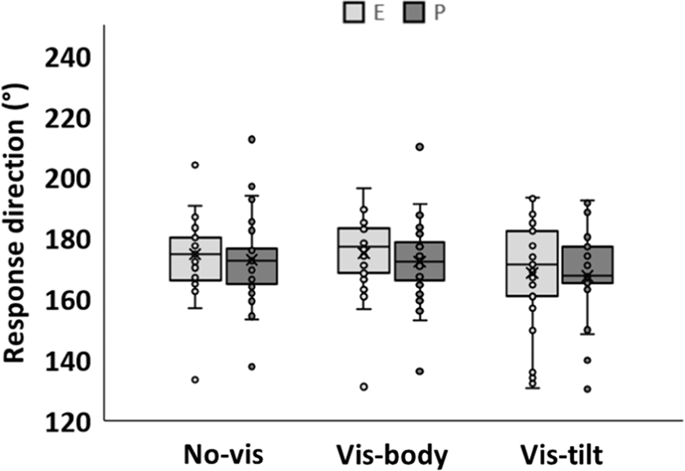npj Microgravity ( IF 5.1 ) Pub Date : 2020-03-03 , DOI: 10.1038/s41526-020-0098-8 Otmar Bock , Nils Bury

|
When participants are asked to flip an omnidirectional switch “down”, the direction of their responses depends mainly on gravicentric, less so on egocentric and least on visual cues about the vertical (Lackner and DiZio, Exp. Brain Res. 130:2−26, 2000). Here we evaluate response direction when gravicentric cues are not available. Participants flipped an omnidirectional switch “down” when gravito-inertial force acted orthogonally to the response plane on earth (session E), and when it was near zero during parabolic flights (session P). We found that the relative weight of visual cues was similar in both sessions, and it was similar to that in an earlier study where participants stood upright. Across all three data sets, the weight of visual cues averaged 0.09. The relative weight of egocentric cues was also similar in both sessions, averaging 0.87; however, it was significantly lower in the earlier study with upright participants, where it averaged 0.43. We further found that informative and noninformative tactile stimulation had no substantial effects on response direction, which suggests that the earlier reported anchoring effect of tactile signals for the perceived vertical may not extend to the motor vertical. We conclude that the absence of gravicentric cues is compensated by a higher weight of egocentric cues, but not by a higher weight of visual cues. As a consequence, astronauts, divers and persons who work on ground in a horizontal body posture may mishandle equipment because of their strong reliance on egocentric cues.
中文翻译:

在没有重力提示的情况下电机垂直
当要求参与者将全向开关“向下”拨动时,他们的反应方向主要取决于重力中心,较少取决于自我中心,至少取决于有关垂直方向的视觉提示(Lackner和DiZio,Exp。Brain Res。130:2-26) ,2000)。在这里,当重力中心提示不可用时,我们评估响应方向。当重力-惯性力与地球的响应平面正交作用时(E部分),以及在抛物线飞行中接近零时,参与者将全向开关“向下”拨动。我们发现,视觉提示的相对权重在两个阶段中都相似,并且与早期研究中站立的人相似。在所有这三个数据集中,视觉提示的权重平均为0.09。在这两个阶段中,以自我为中心的线索的相对权重也相似,平均为0.87。但是,在较早的有直立参与者参与的研究中,这一比例要低得多,平均为0.43。我们进一步发现,信息性和非信息性触觉刺激对响应方向没有实质性影响,这表明较早报道的触觉信号对感知垂直方向的锚定作用可能不会扩展到运动垂直方向。我们得出的结论是,重心提示的缺失可以由较高的自我中心提示权重来补偿,而不能由较高的视觉提示权重来弥补。结果,由于航天员,潜水员和以水平身体姿势在地面上工作的人强烈依赖以自我为中心的线索,因此可能会误操作设备。我们进一步发现,信息性和非信息性触觉刺激对响应方向没有实质性影响,这表明较早报道的触觉信号对感知垂直方向的锚定作用可能不会扩展到运动垂直方向。我们得出的结论是,重心提示的缺失可以由较高的自我中心提示权重来补偿,而不能由较高的视觉提示权重来弥补。结果,由于航天员,潜水员和以水平身体姿势在地面上工作的人强烈依赖以自我为中心的线索,因此可能会误操作设备。我们进一步发现,信息性和非信息性触觉刺激对响应方向没有实质性影响,这表明较早报道的触觉信号对感知垂直方向的锚定作用可能不会扩展到运动垂直方向。我们得出结论,重心提示的缺失可以由较高的自我中心提示权重来补偿,而不能由较高的视觉提示权重来弥补。结果,由于航天员,潜水员和以水平身体姿势在地面上工作的人强烈依赖以自我为中心的线索,因此可能会误操作设备。我们得出结论,重心提示的缺失可以由较高的自我中心提示权重来补偿,而不能由较高的视觉提示权重来弥补。结果,由于航天员,潜水员和以水平身体姿势在地面上工作的人强烈依赖以自我为中心的线索,因此可能会误操作设备。我们得出结论,重心提示的缺失可以由较高的自我中心提示权重来补偿,而不能由较高的视觉提示权重来弥补。结果,由于航天员,潜水员和以水平身体姿势在地面上工作的人强烈依赖以自我为中心的线索,因此可能会误操作设备。


























 京公网安备 11010802027423号
京公网安备 11010802027423号